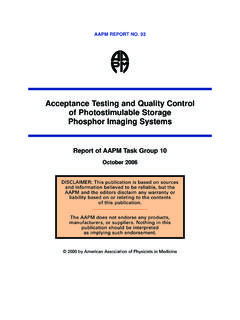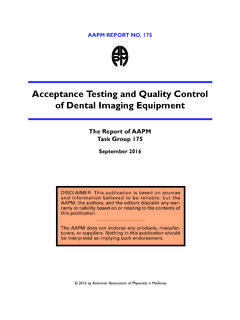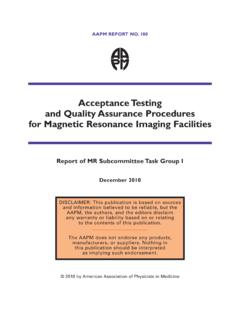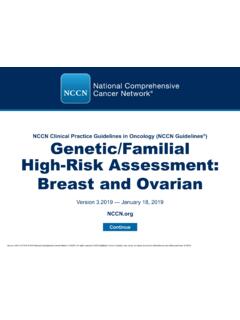Transcription of Abdomen-Pelvis CT protocols - AAPM
1 Abdomen-Pelvis CT protocols Dianna Cody, of texas MD anderson cancer CenterRendon C. Nelson, UniversityDISCLOSURESD ianna:GE Healthcare In Kind research project (Dual-Energy CT)Rendon:GE Healthcare - ConsultantApproach Routine Abdomen-Pelvis CT & kidney stone CT Review ACR CT Dose Index Registry Data Review audience sample protocols Compare to AAPM & speaker s protocols Data specific to one vendor (GE) General tips ACR CT DOSE INDEX REGISTRYCT Abdomen-Pelvis with IV contrastHighest CTDIvol of all passes recordedData reported July-Dec 2012 from ~ 200 facilities ACR database includes nearly 200,000 exams Average CTDIvol 17 mGy, Std Dev 18 mGy MD anderson contributed ~2300 exams Average CTDIvol 19 mGy, Std Dev 7 mGyACR CT DOSE INDEX REGISTRYCT ABD pelvis KIDNEY CALCULUSH ighest CTDIvol of all passes recordedData reported July-Dec 2012 from ~ 200 facilities ACR database includes nearly 22,000 exams Average CTDIvol 16 mGy.
2 Std Dev 9 mGy MD anderson contributed 6 exams Average CTDIvol 19 mGy, Std Dev 4 mGyRoutine abdomen pelvis CT: AAPM protocol Document Importance of tailoring Abdomen-Pelvis CT protocols to size can not be over emphasized. GE User (n=1): Routine abdomen / pelvis CT protocolParameterUser AAPMR otation secDetector configuration16 x mm16 x Index & Img & 5 & 5 mmAlgorithmStandardStandardAdditional recons?? mmIterative Recon?Not AvailableNot AvailableGE LightSpeed 16 Routine Abd/ pelvis CT ParameterUser MDA DFOV<40cmMDA DFOV>42cmRotation secDetector configuration16 x mm 16 x mm16 x Index & Img Thickn & 5 mm 10 & 5 mm12 & 5 mmAlgorithmStandardStandardStandardAddit ional recons?
3 ? mm & mm mm & mmIterative Recon?Not AvailableNot AvailableNot AvailableGE LightSpeed 16 Routine Abd/ pelvis CT Max CTDIvol41 mGyMax CTDIvol 32 mGyKEY FEATURES MDA GE 64-SLICE ABD- pelvis CT protocols :HD750: DFOV < 40cm: 5mm STD (No ASiR), NI 12, mA 200-580, max CTDIvol 36mGy DFOV > 42cm: 5mm STD (No ASiR), NI 14, mA 200-770, max CTDIvol 48mGyVCT: DFOV < 40cm: 5mm STD (No ASiR), NI 10, mA 200-580, max CTDIvol 36mGy DFOV > 42cm: 5mm STD (No ASiR), NI 12, mA 200-770, max CTDIvol 48mGyALL: 120kV, sec, 64 x , pitch , @20% ASiR, for reformatsParameterDukeAAPMR otation secDetector configuration16 x mm16 x Index & Slice Thickness 15 HU & 5 HU & 5 mmAlgorithmStandardStandardAdditional recons?
4 MmIterative Recon?Not AvailableNot AvailableGE LightSpeed 16 Routine Abd/ pelvis CT at Duke ParameterDukeAAPMR otation secDetector configuration64 x mm64 x Index & Slice Thickness 15 HU & 5 HU & 5 mmAlgorithmStandard BB/CAdditional recons? mmIterative Recon?Not AvailableNot AvailableGE VCT 64 Routine Abd/ pelvis CT at Duke ParameterDukeAAPMR otation secDetector configuration64 x mm64 x Index & Slice Thickness 22 HU & 5 HU & 5 mmAlgorithmStandard BB/CAdditional recons? mmIterative Recon?ASiR (40% Blend)ASiR (50% Blend)GE 750 HD 64 Routine Abd/ pelvis CT at Duke GE LightSpeed 16 Renal Stone CT at DukeParameterDukeAAPM (Routine Abd/Pel)Rotation secDetector Configuration16 x mm16 x mmPitch Index, Slice Thickness 15 HU, HU & 5 mmFilterStandard BStandardAdditional Recons?
5 MmIterative Recons?Not AvailableNot AvailableGE VCT 64 Renal Stone CT at DukeParameterDukeAAPM (Routine Abd/Pel)Rotation secDetector Configuration64 x mm64 x mmPitch Index, Slice Thickness HU, HU, mmFilterStandard BB/CAdditional Recons? mmIterative Recons?Not Available*Not Available*GE HD 750 64 Renal Stone CT at DukeParameterDukeAAPM (Routine Abd/Pel)Rotation secDetector Configuration64 x mm64 x mmPitch Index, Slice Thickness 25 HU, HU, mmFilterStandard BB/CAdditional Recons?
6 MmIterative Recons?ASiR (40% blend)ASiR (50% blend)CTDI Chart According ToPatient SizeGE Scanners at DukePatientWidthCTDI vol (mGy)16-SliceCTDI vol (mGy)VCTCTDI vol (mGy)750 HD 25 cm9 (5 - 14) 7 (3 - 10) 4 (2 - 5) 30 cm13 (7 - 20) 12 (6 - 17) 6 (3 - 9) 35 cm19 (9 - 28)21 (10 - 31) 10 (5 - 15) 40 cm26 (18 - 55) 37 (18 - 55) 17 (8 - 25)Mean CTDIC omparison of ACR & Duke DataMean ACRCTDI volMean DukeCTDI vol(all patients)Mean DukeCTDI vol(since 2012) # Exams / # Pts---877 / 3111053 / 403 Abd/Pel CT w IV17 Renal Stone CT16 of bodyNormalized effective doseEDLP(mSv mGy-1cm-1)
7 OUT Fastest rotation speed ( sec) produces more artifacts There is a delay if the rotation speed is changed between sequential scan sets within a series (for example, CAP) No IQ difference with respect to the order images are generated ( acquire thin images, recon thick images ) NI is VERY dependenton the FIRST set of images generated (acquired) May be more efficient work-flow to generate thin images first if reformats are to be produced (do that while waiting on delayed scan for example) LOTS of details can be programmed and saved for each protocolPhilips Users: Routine abdomen / pelvis (n=3) & kidney stone (n=1) CT protocolsPHILIPS BRILLIANCE 64 ROUTINE ABD/ pelvis CTParameterUserAAPMR otation secDetector Configuration32 x mm64 x mmPitch on?
8 (DoseRight)YesYesImage mm5 mmFilterStandard BB/CAdditional recons?-3 mm, mmSiemens Users:Routine abd/ pelvis CT (n=6) &Kidney stone CT (n=4) ProtocolsParametersAbd/PelvisKidney StoneRotation secDetector Configuration24 x mm24 x Ref. mAs180180 Image thickness5 mm3 mmKernelB31fB31fIterative Recon?NoNoSiemens Sensation 64 Routine Abd/ pelvis CT and Kidney Stone CTParametersDukeAAPMR otation secDetector Configuration64 x mm64 x Ref. mAs200210, 150 (with IR)Image mm, mm, mm mm, mmKernelI31B30fIterative Recon?Safire (Power )Safire (Power )Siemens Definition FLASH 64 Routine abdomen / pelvis CT at DukeParametersDukeAAPM (Routine Abd/Pel)Rotation secDetector Configuration64 x mm64 x Ref.
9 MAs200210, 150 (with IR)Image mm, mm, mm, mmKernelI31B30fIterative Recon?Safire (Power )Safire (Power )Siemens Definition FLASH 64 Renal Stone CT at DukeCTDI Chart According ToPatient SizeSiemens Scanners at DukePatientWidthDefinitionFLASH 25 cm6 (3 - 9) mGy 30 cm8 (4 - 11) mGy 35 cm10 (5 - 15) mGy 40 cm12 (6 - 19) mGyToshiba users:Abd/ pelvis CT (n=1)Routine Abdomen-Pelvis CTParameterUserAAPMR otation secDetector configuration80 x mm160 x ( )kV 120120 Standard DeviationStandardStd. ( )Image Thickness5 mm5 mmSure IQ SettingBody Std.
10 Axial, FC18 Body Std. AxialIterative Recon?AIDR3D?KIDNEY STONE CT protocol @ MGHFor follow-up kidney stone exams performed at MGH: Dose reduced by 30-50% relative to routine abd/ pelvis scan NI increased from 13-15 up to 20 if no ASiR is available NI increased from 13-15 up to 25 with 50% ASiR NI increased from 13-15 up to 30 with 60% ASiR NEW protocol uses 80kV & 150mA & VEO (<1 mSv)5mm ImagesKIDNEY STONE protocol @ MAYO Prior to 2010, used an initial screening kidney stone protocol with quality reference mAs of 240 (routine abd/ pelvis ) & a follow-up kidney stone protocol QRM of 160 2010 decision was made to use only the lower technique for all kidney stone exams Has worked well for nearly three years Established at all Mayo sites (MN, AZ, FL) Kidney Stone protocol is 33% reduced from routine abd/ pelvis protocolCourtesy of Jim Kofler, (Lateral dimension), cm15 yr oldSmall AdultMedium AdultLarge AdultExtra-Large AdultSalient points in Abdomen-Pelvis CT protocols Strongly recommend AEC for routine abd- pelvis CT Be aware of potential pitfalls (TCM talk!)













